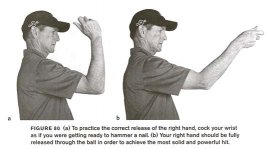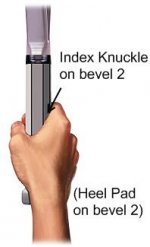Pool is a game of adjustments - some internal, others external
Yes, seperating the back stroke from the delivery is good for many reasons. Everyone has to do it (redirect the pool cue), just some hesitate longer than others, and this is an individual choice based on timing.
It's like "coiling" or you could even imagine drawing back a rubber band, then hesitating while you direct your eyes to the target before releasing. The visual part of the pool shot is focused primarily on the cue ball until this point, then it's totally shifted to the object ball.
Even after contact it's best to allow your eyes to follow the object ball, not the cue ball. I believe it's essential to see what part of the pocket the object ball hits (for important feedback) - a slight adjustment on the next shot {may be needed} if the OB doesn't hit center pocket (if that's where I'm trying to hit).
Pool is a game of adjustments, unless you are performing perfectly, and this just happens a few times a game, or even a set. All things are in a constant state of change, and in competition if you're not getting better, you're getting worse. Make sure you're aware of this and develop a way to make these adjustments in your own game if the Cue Ball or OB doesn't do as you intend. Do not be satisfied with "just making the shot or getting shape," or you are programming yourself for future mistakes.
Strive for perfection, and if you don't achieve it (we seldom do) make the necessary adjustments to continue this pursuit {of perfection} this is what will assure moving in a positive direction. 'The Game is the Teacher'
I didn't read all the posts in this thread but I have to say a 1sec pause has been a HUGE help to me pocketing balls AND with english play specially the longer shots.
Yes, seperating the back stroke from the delivery is good for many reasons. Everyone has to do it (redirect the pool cue), just some hesitate longer than others, and this is an individual choice based on timing.
It's like "coiling" or you could even imagine drawing back a rubber band, then hesitating while you direct your eyes to the target before releasing. The visual part of the pool shot is focused primarily on the cue ball until this point, then it's totally shifted to the object ball.
Even after contact it's best to allow your eyes to follow the object ball, not the cue ball. I believe it's essential to see what part of the pocket the object ball hits (for important feedback) - a slight adjustment on the next shot {may be needed} if the OB doesn't hit center pocket (if that's where I'm trying to hit).
Pool is a game of adjustments, unless you are performing perfectly, and this just happens a few times a game, or even a set. All things are in a constant state of change, and in competition if you're not getting better, you're getting worse. Make sure you're aware of this and develop a way to make these adjustments in your own game if the Cue Ball or OB doesn't do as you intend. Do not be satisfied with "just making the shot or getting shape," or you are programming yourself for future mistakes.
Strive for perfection, and if you don't achieve it (we seldom do) make the necessary adjustments to continue this pursuit {of perfection} this is what will assure moving in a positive direction. 'The Game is the Teacher'

